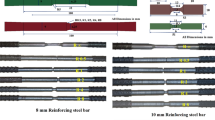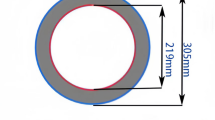Abstract
Progressive collapse is defined as the spread of an initial local failure of a structure. This phenomenon, caused by the removal of one or more load-bearing elements, is followed by a chain of failures through the structure and ultimately leads to partial or even full collapse of an entire structure. As a result, an accurate understanding of structural behavior subjected to large displacements, caused by progressive collapse, is essential to ensure a safe structural design. In this study, the behavior of the beam–column assembly subjected to progressive collapse was investigated by using finite element software. The results were compared to those of the results published in the literature, and model validation was ensured. The progressive collapse resistance mechanisms in RC beam–column assembly as well as the effectiveness of each mechanism in progressive collapse prevention were investigated. According to the results, the four resistance mechanisms, i.e., flexural action, compressive arch action, plastic hinge formation, and catenary action, have a significant effect on structural behavior.








Similar content being viewed by others
References
ABAQUS (2012) Standard user’s manual version 6.12, Hibbitt, Karlsson & Sorensen Inc. Rhode Island, USA
Abbasnia R, Nav FM (2016) A theoretical method for calculating the compressive arch capacity of RC beams against progressive collapse. Struct Concrete 17:21–31. https://doi.org/10.1002/suco.201400119
ACI 318-05 (2005) Building code requirements for structural concrete. American Concrete Institute, Farmington Hills, Michigan, USA
ASCE7-16 (2017) Minimum design loads and associated criteria for buildings and other structures. American Society of Civil Engineers, Reston, VA
Bao X, Li B (2010) Residual strength of blast damaged reinforced concrete columns. Int J Impact Eng 37:295–308. https://doi.org/10.1016/j.ijimpeng.2009.04.003
Bao Y et al (2008) Macromodel-based simulation of progressive collapse: RC frame structures. J Struct Eng 134:1079–1091. https://doi.org/10.1061/(ASCE)0733-9445(2008)134:7(1079)
British Standard Institute (1996) Loading for buildings—part 1: code of practice for dead and imposed loads—BS 6399. London, UK
British Standard Institute (1997) Structural use of concrete, Code of practice for design and construction—BS 8110. London, UK
British Standard Institute (2003) Structural use of steelwork in building, Design in composite construction, Code of practice for design of simple and continuous composite beams—BS 5950. London, UK
British Standard Institute (2005) Code of Practice for Use of Masonry, Structural use of reinforced and prestressed masonry—BS 5628. London, UK
Brunesi E et al (2015) Progressive collapse fragility of reinforced concrete framed structures through incremental dynamic analysis. Eng Struct 104:65–79. https://doi.org/10.1016/j.engstruct.2015.09.024
Brunesi E, Nascimbene R (2014) Extreme response of reinforced concrete buildings through fiber force-based finite element analysis. Eng Struct 69:206–215. https://doi.org/10.1016/j.engstruct.2014.03.020
Brunesi E, Parisi F (2017) Progressive collapse fragility models of European reinforced concrete framed buildings based on pushdown analysis. Eng Struct 152:579–596. https://doi.org/10.1016/j.engstruct.2017.09.043
DoD (2009) Design of building to resist progressive collapse. Department of Defense, Unified Facility Criteria, Washington DC, USA, UFC-4-023-03
Dusenberry DO, Juneja G (2002) Review of existing guidelines and provisions related to progressive collapse. National Workshop on Prevention of Progressive Collapse, Rosemont
EN 1992-1-1 (2004) Eurocode 2: design of concrete structures—part 1–1: general rules and rules for buildings. Management
EN 1991-1-7 (2006) Eurocode 1: actions on structures—Part 1–7: general actions—Accidental actions. European Committee for Standardization
Ferahian RH (1972) Buildings: design for prevention of progressive collapse, Civil Engineering, American Society of Civil Engineers. American Society of Civil Engineers, New York
GSA (2003) Progressive collapse analysis and design guidelines for new federal Office Buildings and Major Modernization Projects. The US General Services Administration, Washington DC, USA
Krauthammer T (1999) Blast-resistant structural concrete and steel connections. Int J Impact Eng 22:887–910. https://doi.org/10.1016/S0734-743X(99)00009-3
Kripakov NP, Sun MC, Donato DA (1995) ADINA applied toward simulation of progressive failure in underground mine structures. Comput Struct 56:329–344. https://doi.org/10.1016/0045-7949(95)00026-D
Lee CH et al (2009) Simplified nonlinear progressive collapse analysis of welded steel moment frames. J Constr Steel Res 65:1130–1137. https://doi.org/10.1016/j.jcsr.2008.10.008
Nair RS (2006) Preventing disproportionate collapse. J Perform Construct Facil 20:309–314
NBCC (2005) National Building Code of Canada. ON, Canada, Ottawa
Paripour MB, Budak A, Düzgün OA (2018) Numerical investigation of reinforced concrete frame behavior subjected to progressive collapse. Chall J Struct Mech 4:117–125. https://doi.org/10.20528/cjsmec.2018.03.005
Parisi F, Scalvenzi M, Brunesi E (2018) Performance limit states for progressive collapse analysis of reinforced concrete framed buildings. Struct Concrete. https://doi.org/10.1002/suco.201800039
Pearson C, Delatte N (2005) Ronan point apartment tower collapse and its effect on building codes. J Perform Construct Facil 19:172–177. https://doi.org/10.1061/(ASCE)0887-3828(2005)19:2(172)
Starossek U (2007) Typology of progressive collapse. Eng Struct 29:2302–2307. https://doi.org/10.1016/j.engstruct.2006.11.025
Su Y, Tian Y, Song X (2009) Progressive collapse resistance of axially-restrained frame beams. ACI Struct J 106:600–607
Tsai MH (2012) Evaluation of different loading simulation approaches for progressive collapse analysis of regular building frames. Struct Infrastruct Eng 8:765–779. https://doi.org/10.1080/15732479.2010.485620
Yu J,Tan KH (2010) Progressive collapse resistance of RC beam-column subassemblages. In: Design and analysis of protective structures (conference 3rd:2010:Singapore), pp 74–83
Yu J, Tan KH (2013) Experimental and numerical investigation on progressive collapse resistance of reinforced concrete beam column sub-assemblages. Eng Struct 55:90–106. https://doi.org/10.1016/j.engstruct.2011.08.040
Author information
Authors and Affiliations
Corresponding author
Rights and permissions
About this article
Cite this article
Paripour, M.B., Budak, A. & Düzgün, O.A. Investigation of Progressive Collapse Resistance Mechanism in Reinforced Concrete Beam–Column Assembly. Iran J Sci Technol Trans Civ Eng 45, 505–512 (2021). https://doi.org/10.1007/s40996-020-00409-6
Received:
Accepted:
Published:
Issue Date:
DOI: https://doi.org/10.1007/s40996-020-00409-6




